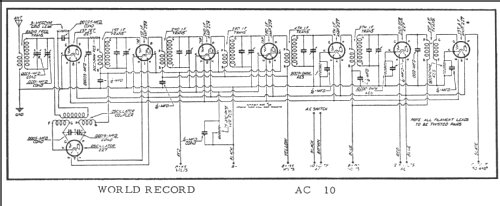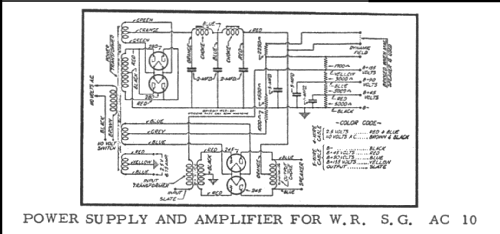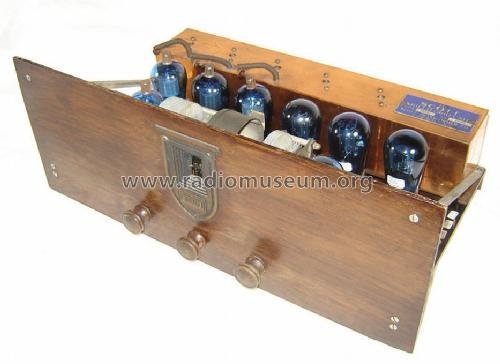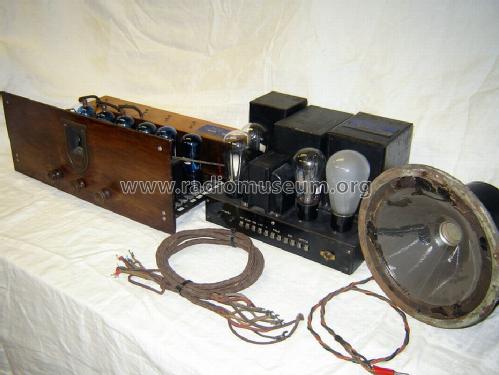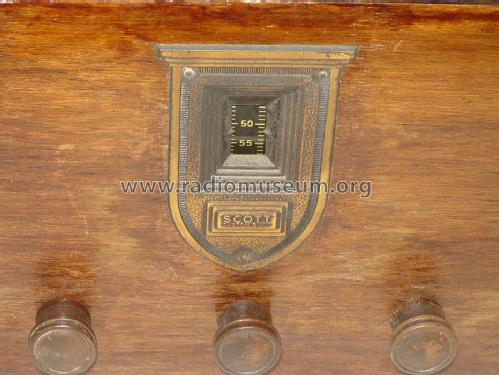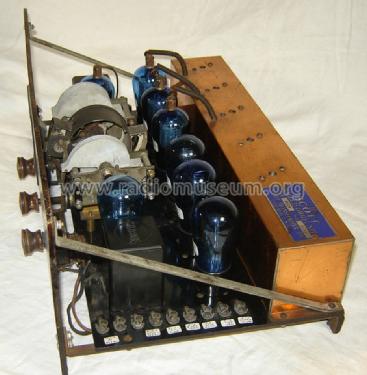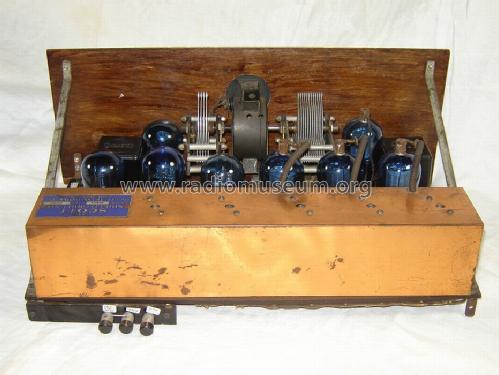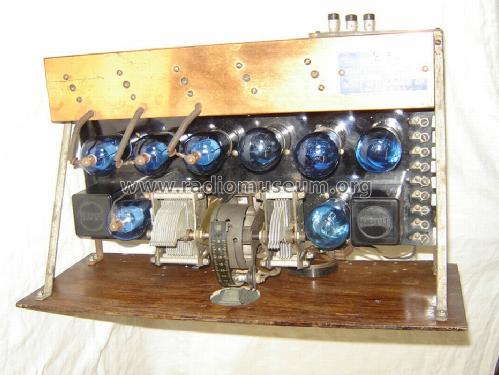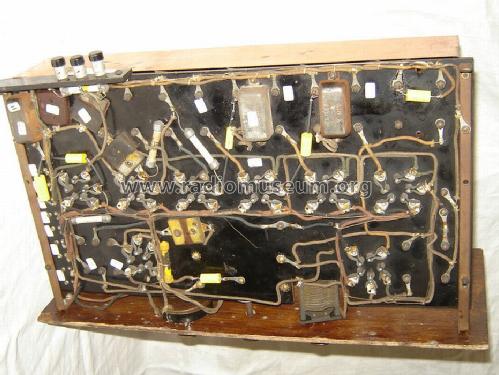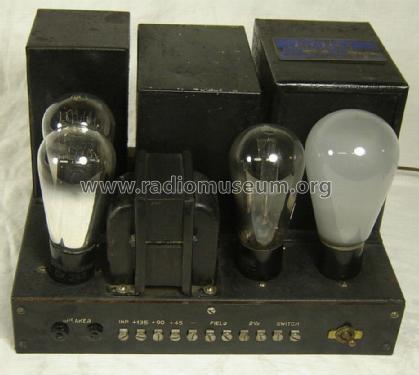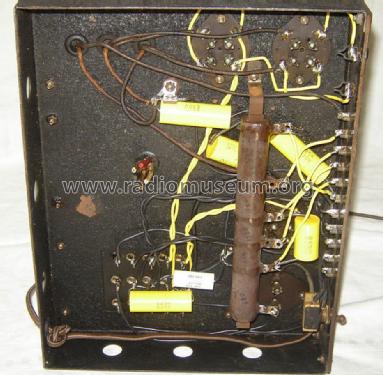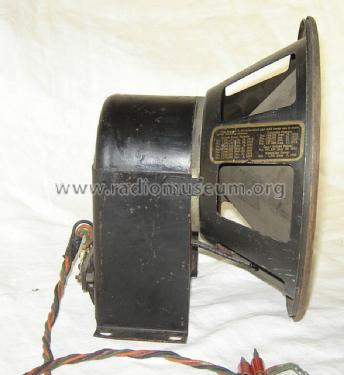World's Record Shield Grid AC10 (small escutcheon) 3x24A
Scott Radio Labs.(E.H., Transformer); Chicago (IL)
- Produttore / Marca
- Scott Radio Labs.(E.H., Transformer); Chicago (IL)
- Anno
- 1929
- Categoria
- Radio (o sintonizzatore del dopoguerra WW2)
- Radiomuseum.org ID
- 55394
Clicca sulla miniatura dello schema per richiederlo come documento gratuito.
- Numero di tubi
- 12
- Principio generale
- Supereterodina (in generale)
- Gamme d'onda
- Solo onde medie (OM).
- Tensioni di funzionamento
- Alimentazione a corrente alternata (CA) / 110 Volt
- Altoparlante
- AP elettrodinamico (bobina mobile e bobina di eccitazione/di campo) / Ø 8 inch = 20.3 cm
- Materiali
- Mobile di metallo
- Radiomuseum.org
- Modello: World's Record Shield Grid AC10 [3x24A] - Scott Radio Labs.E.H.,
- Forma
- Chassis o in scatola da montaggio
- Annotazioni
- 11 or 12 tubes counting rectifier and/or ballast.
- Prezzo nel primo anno
- 220.00 $
- Fonte esterna dei dati
- Ernst Erb
- Fonte dei dati
- Radio Collector`s Guide 1921-1932
- Bibliografia
- E.H.Scott Radio Collectors Guide (1925-1946)
- Altri modelli
-
In questo link sono elencati 201 modelli, di cui 126 con immagini e 51 con schemi.
Elenco delle radio e altri apparecchi della Scott Radio Labs.(E.H., Transformer); Chicago (IL)
Discussioni nel forum su questo modello: Scott Radio Labs.E.H: World's Record Shield Grid AC10
Argomenti: 1 | Articoli: 1
In July 1929, Hugo Gernsback launched his newest radio magazine, Radio Craft. In the premier edition, we find a column ad announcing the new Scott Shield Grid AC 10. A two page ad also appeared in the July issue of Radio magazine, and by September, a complete article and two page advertisements appeared in the Citizen’s Radio Callbook. As described in the Callbook article, the AC 10 uses type 224 tubes for the first three IF stages. All other tubes on the tuner chassis are type 27 (oscillator, first and second detectors, fourth IF stage and first audio stage. Final audio amplification is on the power supply, using two of the relatively new type 45 output tubes in push-pull. The two type 80 rectifiers are not counted in Scott’s lineup. The amplifier is designed to feed an eight inch electro-dynamic speaker. At this time, Scott obtained speakers from the Rola company, but had decals applied to the speaker showing the Scott name.
The AC 10 circuit has a number of changes from the previous designs. Scott has eliminated the separate RF stage, mixing the antenna transformer directly with the oscillator output. Volume control is obtained by varying the cathode bias on the common connection between the three type 24 IF tubes. The set contains a fourth IF stage, and the IF line is peaked at a somewhat non-standard 480Kc. The compatibility of the 222AC and the type 24 tube is also evidenced in the AC 10. One apparently early schematic of the tuner chassis clearly shows 222AC tubes for the first three IF stages.
The AC 10 survived from its 1929 introduction through the fall of 1930, slightly over a year. The first versions of the set sported a large, bronzed face plate covering the entire area around the tuning window and controls. Later versions have a much smaller dial scale, and use a small bronze escutcheon shaped like an inverted cathedral. In early 1930, the circuit was upgraded to use a type 24 tube as the first detector. Additionally, the volume control was extended from biasing the three IF stages to include the cathode of the first detector. The result was a slightly more responsive volume control action. Finally, the transformer coupling between the second detector and the first AF stage was replaced by a resistance coupling, probably to reduce parts costs. The power supply also received an upgrade. The rectifier was reduced to a single 80 tube, and a type 12-20 line regulator tube was added to improve set voltage stability.
The AC-10's success was undoubtedly helped by the variety of accessories that Scott offered. One of these accessories was an “outboard” short-wave converter. Packaged in a copper case not quite six inches square, the short-wave converter used three coils to cover wavelengths from 3.9 MHz to just over 20 MHz. (36-76m, 23-40m and 14-25m).
In addition to the remote control and the short-wave converter, a January 1930 order form listed the following accessories: A walnut cabinet with dynamic speaker at $60, a console electro-magnetic speaker at $15, a Scott radio bench (similar to a piano bench) at $22, and the short-wave converter and remote control at $32.50 and $50 respectively.
Kent King, 01.Sep.06
